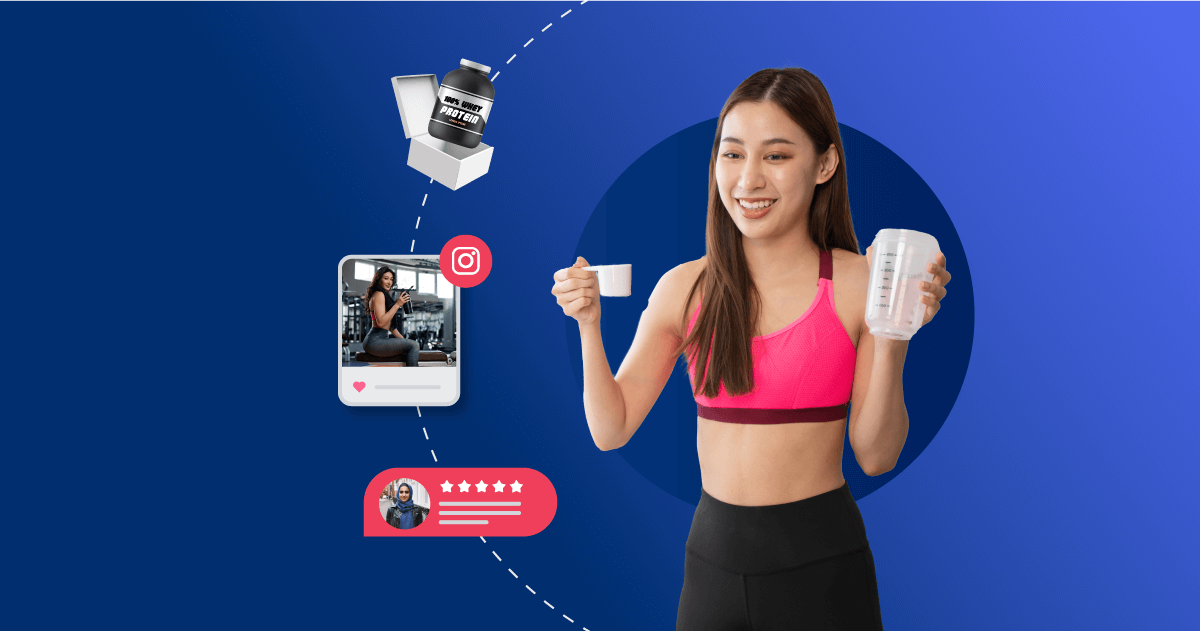October 10, 2024
“I want as many likes as I can get, and don’t really care about ROI.”
This is said by exactly zero marketers today (we hope).
But the funny thing? In practice, it’s not totally far from where creator and influencer marketing have been. As an industry, we’re still digging out from all those vanity metrics (likes, shares, comments) that used to dominate our “Results” slides and determine the kinds of influencers we used to engage—influencers who might have been all kinds of wrong for our brands.
And maybe that’s why there’s still a perception that measuring the success of an influencer marketing campaign or creator ROI can be challenging. How do we know whether a creator is creating content that drives our brand forward?
We’re here to tell you that it can be done—with scientific precision and more efficiently than you might think.
In this blog, we’ll look at five tips for measuring creator performance, from behavioural to technical. Follow them, and you’ll have a systematic way to set your creator up for success — and then make sure they stick to the landing.
On metrics: See the whole picture
Lots of measurement efforts go astray before the influencer has even been engaged.
How is that possible? It’s easy for marketers to have a limited view of what they hope to achieve. Picking the right metrics is everything.
As part of your preliminary campaign strategy, you need to determine your ultimate goal. It might be changing existing brand perceptions, increasing brand awareness and audience growth, or driving sales. Each is a valid goal, and each requires a different kind of campaign—possibly with a different kind of creator.
Why different kinds of creators? Let’s look at two: @TravelBabbo, on Instagram, is known for family travel adventures and beautiful destination photography. This creator is all about inspiration and scroll-stopping content, making him a natural choice for a high-level awareness campaign.
Conversely, Marques Brownlee (@MKBHD) is known for his surprisingly thorough product reviews of tech gear, always featuring price points — precisely the sort of information you want to pass on to interested shoppers lower in the funnel. (That is, if you can afford him.)
You must have a firm handle on the desired outcome before you can plan the rest. In the table below, you’ll see how each creator’s performance outcome is tied to specific metrics, telling you what to track.
| Outcome | Magnitude | Efficiency |
| Awareness | Impressions, follower count, brand mentions, new customers | CPM (cost per 1,000 impressions) Share of voiceNew customer acquisition rate |
| Engagement | Likes, comments, shares, clicks, site traffic | Engagement rate, cost per engagement, cost per click, click-through rate, earned media value (EMV) |
| Content supply chain | Number of engaged creators, content volume, audience sentiment, and volume of actionable product feedback and ideas, number of retailers syndicating content to. | Cost per piece of content, revenue per creator |
| Sales | Revenue, onsite conversions, and average order value | Return on investment, conversion rate |
Achieving metrics mind-meld with your creator
Reminder: your creator is not part of your internal marketing team.
And that’s why we love them, right? Creators bring an authentic, outside perspective that cuts through ad fatigue and casts your brand in a human, relatable light. You don’t want them to be marketers.
But sometimes it would be pretty nice if they thought like marketers, right?
The reality is that brands and creators often speak different measurement languages. When a creator thinks about success, it usually concerns the softer side of metrics. They thrive on fun content, interactions, and boosting brand awareness. They know that by building up a brand’s reputation and getting people excited, they’re setting the stage for future sales.
That’s not to say that brands don’t care about creator brand lift, which can be a golden ticket for marketers trying to shift budgets away from traditional media. Brands look at shifts in brand perception, favorability, and overall awareness caused by influencer collaborations to prove that influencer magic can do what old-school ads used to — and maybe even better.
But when brands talk about success, they’re usually also talking about conversion lift: those concrete actions that scream engagement and potential sales down the line. Think leads, downloads, sign-ups, and registrations. These metrics tell them how well influencer content is driving people to take action right now.
So, in effect, we’re back to Tip #1: knowing what you want to achieve and planning accordingly. Except now you have to communicate these goals to your creator in a transparent, understandable, non-marketing-lingo way.
They need to know how their content contributes to the big picture. You might need to do some educating or nudging. But it’s crucial to put in this work early so you and your creator are speaking the same language for all engagements.
Set realistic benchmarks
Executing a creator campaign (or any kind, really) without accurate benchmarking is like taking a long road trip with a wonky GPS. You might get where you’re going, but not before a few wrong turns and some head-scratching.
Why benchmarking matters
Knowing where you stand: Benchmarks give you a reference point to compare creator performance. Without them, how do you know if your 2% engagement rate is good, bad, or downright ugly? Benchmarks provide context, helping you understand what success looks like in your industry.
Setting expectations: Clear benchmarks set realistic expectations for both you and your influencers. They help avoid those awkward conversations where you’re disappointed with the results, but the influencer thinks they’ve knocked it out of the park.
Tracking progress: With benchmarks in place, you can track your progress over time. Are your campaigns improving, stagnating, or declining? Regularly comparing your creator ROI numbers to benchmarks helps you adjust strategies and keep your efforts on an upward trajectory.
How to research and set accurate benchmarks for creator performance
Industry standards: This should be your first step when you set benchmarks. Look at reports and case studies from reputable sources like marketing research firms, industry publications, and analytics companies. They often provide benchmark data for key metrics like engagement rates, click-through rates, and ROI. Industry standards can be radically different: for example, a good click-through-rate (CTR) for content in the real estate industry is 1.91%; a good CTR for home and garden is 3.47%.
Competitor analysis: Peek over the fence to see what your competitors are up to. Analyze their campaigns and creator performance metrics if available. While you won’t get all the details, tools like social media analytics and competitive analysis platforms can give you a good sense of where you stand relative to your peers.
Historical data: Use your own historical data as a benchmark. If you’ve run creator campaigns before, analyze past performance to set realistic goals. Look at what worked, what didn’t, and establish baselines based on your own experiences.
We’ll get you started. Here are some very general benchmarks you can start thinking about before zeroing in on industry, competitors, and past performance:
- Return on Investment (ROI): Aim for an ROI in the range of 5x-11x, meaning for every $1 invested, you aim to generate $5-$11 in return
- Click-Through Rate (CTR): A good benchmark for influencer marketing is typically 2%-5%
- Engagement Rate: Micro-influencers often achieve a 2%-4% engagement rate on Instagram, while macro-influencers tend to range from 1%-2%
- Cost per Engagement: Costs can vary widely, from $0.10-$1.00 for average accounts, $0.05-$0.50 for micro-influencers, and $0.01-$0.25 for nano-influencers on Instagram
Track and track again
You’ve got your goals in place. You’ve kicked off your creator, and they’re beginning to post. Now it’s time to start tracking.
It might seem OCD to continually check in on campaign performance numbers, especially as they’re being generated. But doing so allows you to accomplish a few things at once.
Spot emerging trends: In the time it takes your campaign to ramp up, memes and cultural moments will come and go; what played well yesterday might be done today. Constant tracking allows you to spot trends early and capitalize on emerging opportunities before they become yesterday’s news.
Optimize on the fly: Is your creator resonating with your audience? Are engagement rates soaring or sinking? Are people responding to your gif posts more than your long-form videos? Tracking creator performance provides the insights needed to tweak your campaign in real-time.
Get the most out of your budget: Every dollar has to work hard. Constant creator ROI tracking helps you allocate your budget wisely, focusing investments on the tactics and strategies delivering the best results.
Get to know your audience: Collecting data on your audience’s tastes and digital behaviors — like knowing the time of day that most of your audience interacts — gives you invaluable insights for optimizing today and strategizing for the future.
Now. Maintaining oversight on all of these creator performance metrics at once might seem like a big job. But we’ve got you covered with our final tip.
Use a creator marketing platform
And it’s not just for tracking. When it comes to managing the creator relationship, these platforms do it all.
The creator economy has matured to the point that we now have technology designed specifically to help you get what you need from creators without the busywork.
Creator marketing platforms are software suites that help you:
- Search, identify, and contact creators around the globe
- Manage communications, contracts, and schedules
- Review content work in progress
- Track campaign performance in real-time, including e-commerce and affiliate sales
- Weed out fake engagement
- Coordinate with e-commerce stores to offer promotions and samples
- Generate comprehensive end-of-campaign reports
- Set up secure creator payment plans
Bazaarvoice affable.ai is our end-to-end AI-driven creator marketing platform that lets you do all of the above — and we’re pretty dang proud of it. You can check out our complete guide to this exciting platform technology.
Picking the right goals and having industry-leading technology to track them for you: this is how to make sure your creators are influencing, your dollars are hustling, and your ROI is as close to a sure thing as you can get. There will always be variables and contingencies in every campaign. But the key is to control what you can.
And never again settle for guesswork.





